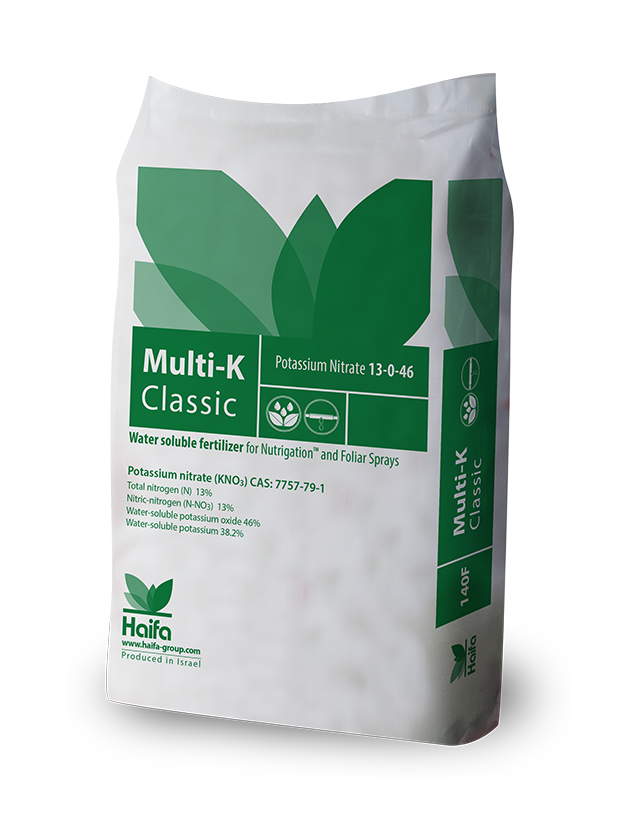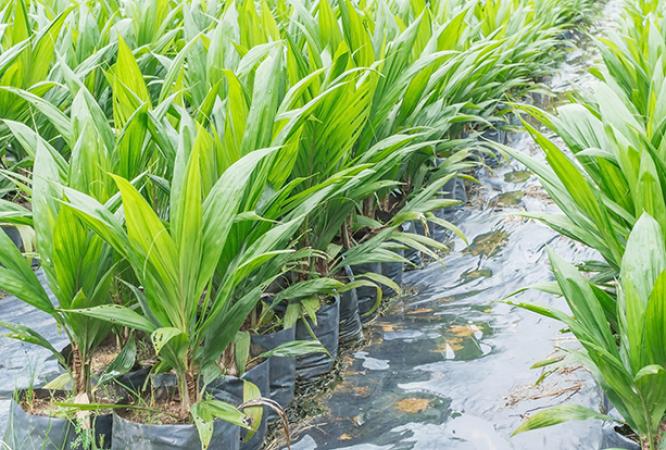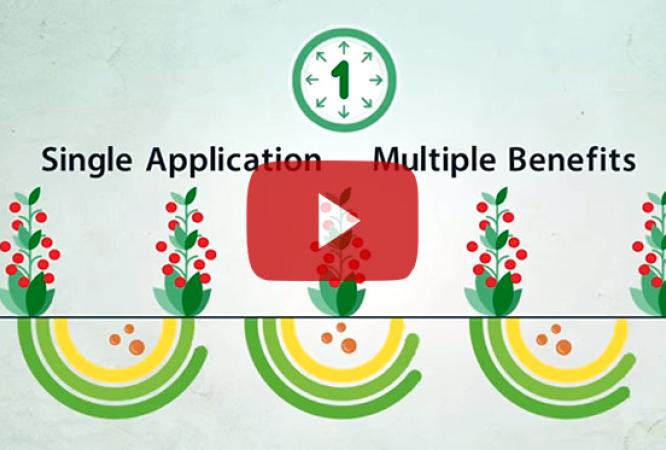Find out how to supply the banana trees with the proper amount of nitrogen, phosphorous and potassium using Haifa's fertilizers
Plant Population: 1200-1800 mat/Ha.
Expected Yield: 45-50 t/Ha.
Amounts of elements removed from the soil in the yield (Kg/Ha/Year):
K-1500; N-500; P-70; Ca-235; Mg-155; Mn-13; Fe-5.5; Zn-1.7; B-1.4; Cu-0.55.
Recommended average rates of nutrients for banana (Kg/Ha/Year):
| N | P2O5 | K2O |
|---|---|---|
| 400-600 | 200-300 | 850-1100 |
Nitrogen applications should be split into several dressings, ranging from intervals of 1-3 months in a relatively dry climate, to every 2-4 weeks in humid tropical areas. Urea is not recommended for dry land conditions. Potassium nitrate is very suitable for banana trees especially because it supplies both N and K in the ratio of 1:3, which perfectly corresponds to the amounts removed in the yield (see above).
Phosphorous requirement is not large, and deficiency symptoms are rarely seen in the field. It is relatively mobile and can be re-utilized in the plant. P may be leached if drip irrigation is employed. Under such conditions frequent P applications may be needed.
Best fertilization regime should be based on leaf or soil analysis.
Potassium is a key element in banana tree nutrition. Insufficient K supply reduces the total dry matter production in the plant, and its distribution within the plant. The organ most drastically affected is the bunch. The most universal symptom of K deficiency is the appearance of orange-yellow chlorosis of the oldest leaves and their subsequent rapid death. Other effects are reduced leaf size, delay in flower initiation, reduced fruit number/bunch and hand number/bunch, and especially - fruit size. Sudden shortages of K can occur if the K release rates of the soil do not match changes in seasonal demand for K by the plant. In these instances the plant may initiate its bunch well, and then, the leaf system will suddenly collapse as K is withdrawn from the leaves to supply the needs of the growing fruit.
Potassium application method is generally similar to that of nitrogen, but dressing should be less at the beginning of growth period, and increased immediately before and after flowering.
The best fertilization practice for subtropical regions is to divide the entire amount of fertilizers by the number of irrigation weeks. The fertilizers are supplied therefore, in weekly doses.
Values of elements concentrations standards (as sampled in lamina #3 in 13 Cavendish varieties).
| Element | Standard | |
|---|---|---|
| N | (%) | 3.69 |
| P | (%) | 0.21 |
| K | (%) | 3.27 |
| S | (%) | 0.28 |
| Ca | (%) | 0.79 |
| Mg | (%) | 0.36 |
| Cl | (%) | 0.76 |
| Al | (ppm) | 41 |
| Fe | (ppm) | 150 |
| Mn | (ppm) | 1476 |
| Cu | (ppm) | 12.1 |
| Zn | (ppm) | 17.6 |
| B | (ppm) | 16.8 |
| Mo | (ppm) | 0.16 |
Nutrigation
The total amount of fertilizers (Kg/Ha) should be split as follows:
| Season | Nutrient requirement | Recommended fertilizer | ||||
|---|---|---|---|---|---|---|
| N | P2O5 | K2O | AN | MAP | Multi-K | |
| Spring | 130-200 | 100-150 | 300-350 | 80-200 | 160-250 | 650-760 |
| Summer | 150-230 | - | 300-400 | 200-350 | - | 650-870 |
| Autumn | 120-170 | 100-150 | 250-350 | 90-125 | 160-250 | 550-750 |
| Total | 400-600 | 200-300 | 850-1100 | 370-675 | 320-500 | 1850-2380 |
AN = Ammonium Nitrate (34% N)
Multi-K = Potassium nitrate (13%N ; 46% K2O)
MAP = Monoammonium Phosphate (12% N ; 61% P2O5)

Why Use Multi-K
Sensitivity to salinity - The Banana plant has a relatively moderate resistance to salinity.
When soil has a concentration of 100-500 ppm soluble salts Banana growth is satisfactory. From 500 ppm plants are affected and from 1000 ppm plants are stunted or dead.
The 1:3 (nitrogen:potassium) ratio is required by the banana plant which makes Multi-K to the ideal fertilizer for it.
Foliar spray, Mexico
Source: O. Rotenberg. 21/2/97
Poly-Feed 20-5-30 + M.E.
A company that owns 1100 Ha started spraying 1.5 Kg/Ha at 8 days intervals, year round. 112.5 Kg Poly-Feed are dissolved in 1500 liter air plane tank (conc. of 7.5%), and sprayed from the air.
Need more information about growing bananas? You can always return to the banana crop guide table of contents & banana fertilizers






